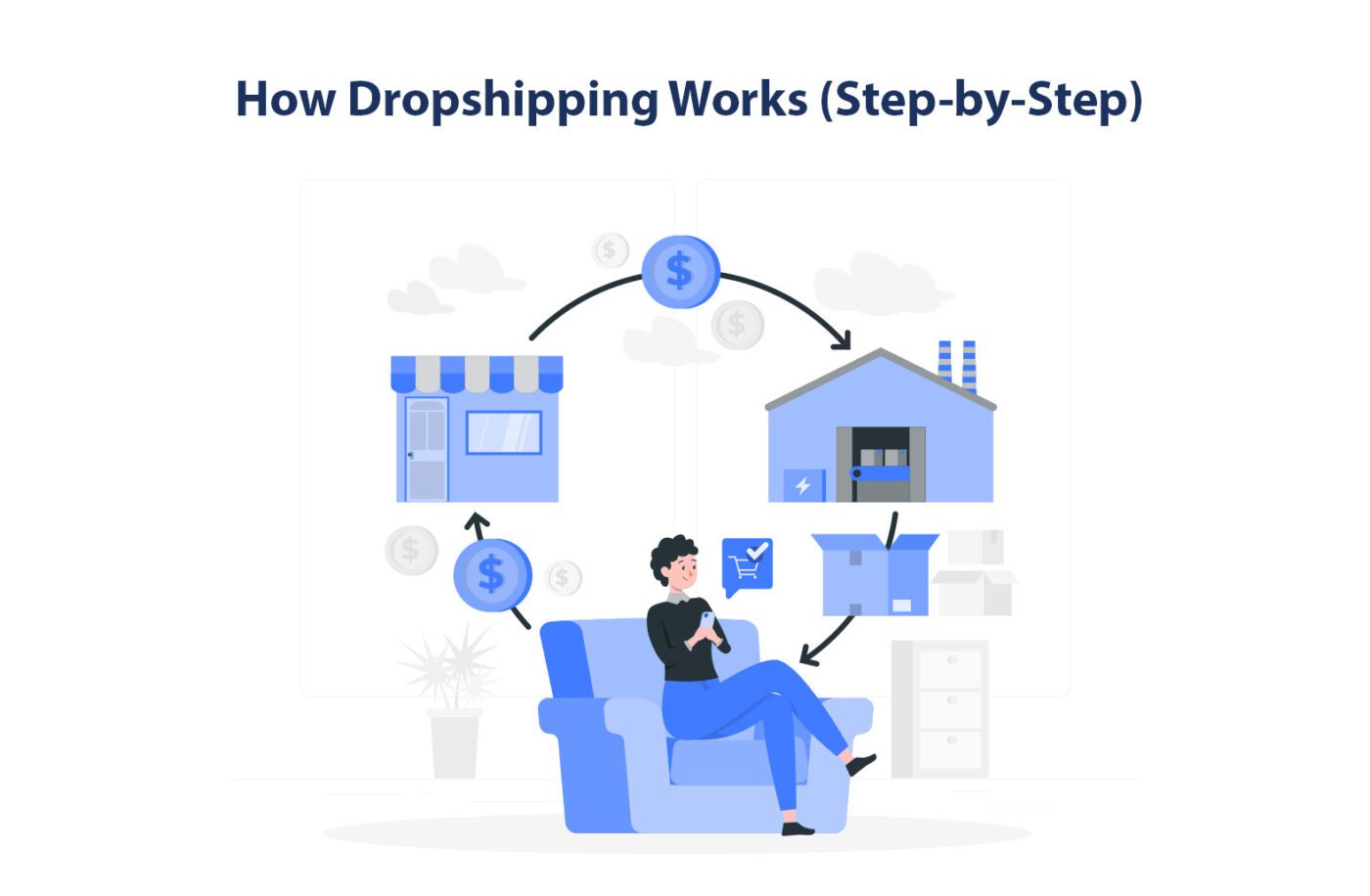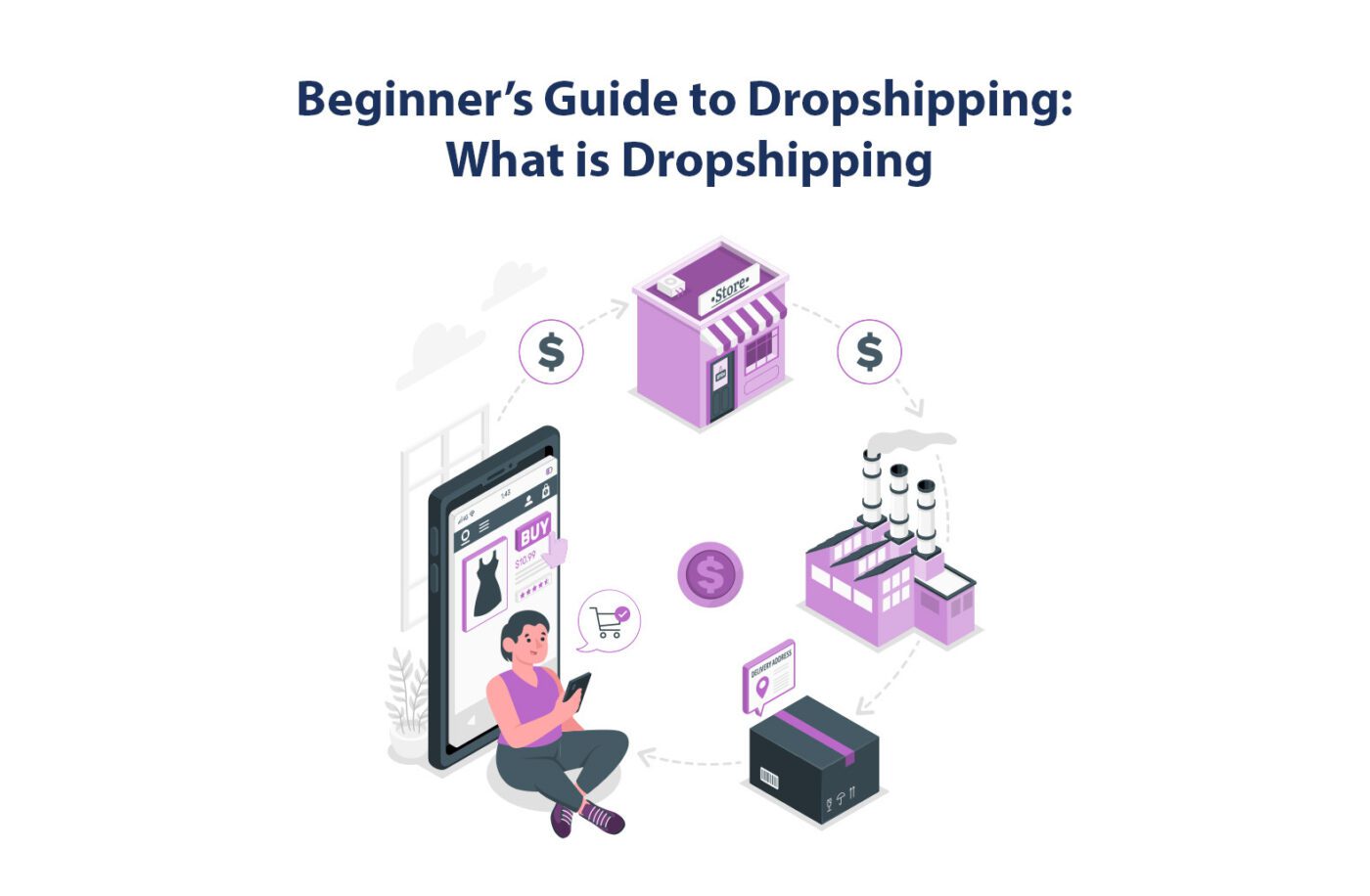Dropshipping is a popular retail business model that allows you to start your online store without the hassle of managing inventory. In this guide, we’ll break down the definition of dropshipping, how it works step-by-step, its pros and cons, and the different types of dropshipping to help you kickstart your e-commerce journey.
What is Dropshipping?
Dropshipping is a retail business model where you sell products in your online store without needing to keep them in stock. Instead, when a customer makes a purchase, you buy the product from a supplier who ships it directly to the customer.
How Dropshipping Works (Step-by-Step)

- Choose a Niche: Select a specific product category or niche for your online store.
- Set up Your Store: Create an online store using platforms like Shopify, WooCommerce, or others. Design your website, add product listings, and set prices.
- Find Suppliers: Locate reliable suppliers or wholesalers who offer dropshipping services. Popular options include AliExpress, SaleHoo, and contacting manufacturers directly.
- Import Products: Add products from your chosen suppliers to your store, including images and product descriptions.
- Customer Places an Order: When a customer buys a product from your store, you receive the order details and payment.
- Place the Order with Supplier: Manually or automatically, order the product from your supplier, providing the customer’s shipping details.
- Supplier Ships the Product: Your supplier ships the product directly to the customer, typically with your branding or unbranded.
- Customer Receives the Product: The customer receives the product without your direct involvement.
- Customer Service: Handle customer inquiries, returns, and issues, providing excellent service.
- Profit: You make a profit from the difference between the price you charged the customer and the cost you paid to the supplier.
Understand What is Dropshipping: Pros and Cons

Pros:
- Low Initial Investment: Minimal upfront costs compared to traditional retail.
- Wide Product Variety: Offer a wide range of products without holding inventory.
- Location Flexibility: Operate from anywhere with an internet connection.
- Low Overhead: No need for warehousing or inventory management.
- Scalability: Easily expand your product range and business size.
Cons:
- Lower Profit Margins: Competitive market can lead to thinner profits.
- Limited Control: You rely on suppliers for product quality and shipping.
- Shipping Times: Longer shipping times can affect customer satisfaction.
- Intense Competition: Many dropshippers sell the same products, increasing competition.
- Customer Service: Handling customer issues can be time-consuming.
Types of Dropshipping
General Dropshipping
General dropshipping, also known as broad dropshipping, is a versatile approach that involves selling a wide range of products across various categories.
Pros:
- Diverse Customer Base: Selling a variety of products can attract a broader audience, increasing your potential customer base.
- Adaptability: You can easily switch between products and niches to respond to changing market trends.
- Lower Risk: Spreading your offerings across categories can reduce the risk associated with fluctuations in demand.
Cons:
- Fierce Competition: General dropshipping often means competing with numerous other sellers, making it challenging to stand out.
- Lack of Expertise: You might struggle to provide in-depth product knowledge or personalization.
- Brand Identity: Building a strong brand can be more challenging when your focus is on various products.
Choosing General Dropshipping:
Opt for general dropshipping if you prefer flexibility and are willing to put in extra effort to differentiate your store. Consider it if you’re comfortable with a potentially higher level of competition and want to test various markets quickly.
Niche Dropshipping
Niche dropshipping involves concentrating on a specific product category or a narrower market segment.
Pros:
- Targeted Audience: Niche stores attract customers with a strong interest in a specific product category, leading to higher conversion rates.
- Authority Building: Focusing on a niche allows you to become an expert in that field, building trust with your audience.
- Lower Competition: Niche markets often have fewer competitors, making it easier to establish your presence.
Cons:
- Limited Growth: Your potential customer base may be smaller, which could limit your long-term growth potential.
- Market Volatility: Niche markets may be more susceptible to economic fluctuations.
- Risk of Saturation: If your chosen niche becomes oversaturated, it can be challenging to gain a foothold.
Choosing Niche Dropshipping:
Select niche dropshipping if you have a passion or expertise in a specific area. It’s an excellent choice if you prefer a targeted approach and are willing to focus your marketing efforts on a smaller but more engaged audience.
Brand Building Dropshipping
Brand building dropshipping involves creating a unique brand identity and selling products under your own brand name.
Pros:
- Brand Loyalty: Building a brand allows you to develop a loyal customer base that trusts your products.
- Higher Profit Margins: Owning your brand enables you to command higher prices and increase your profit margins.
- Long-Term Sustainability: A well-established brand can lead to long-term success and even expansion into other business ventures.
Cons:
- Higher Initial Investment: Creating a brand requires more investment in marketing, product development, and brand-building activities.
- Time-Consuming: Building a brand takes time and consistent effort, which might not yield immediate results.
- Responsibility: You’re responsible for product quality, customer service, and brand reputation.
Choosing Brand Building Dropshipping:
Opt for brand-building dropshipping if you’re committed to long-term success and are willing to invest time and resources into creating a unique brand identity. This model is suitable for entrepreneurs who seek higher profit potential and brand recognition.
Tips for Starting a Successful Dropshipping Business
- Niche Selection: Choose a niche you’re passionate about and that has demand but isn’t overly saturated.
- Research Suppliers: Partner with reliable and reputable suppliers with a track record of quality and prompt shipping.
- Competitive Pricing: Set competitive prices to attract customers while maintaining a healthy profit margin.
- Quality Product Listings: Write compelling product descriptions and use high-quality images to entice buyers.
- Customer Service: Provide excellent customer service to build trust and gain repeat business.
- Marketing and Promotion: Invest in marketing strategies like SEO, social media, and advertising to drive traffic to your store.
- Inventory Management: Keep track of your supplier’s inventory to avoid selling out-of-stock items.
- Continuous Learning: Stay updated with industry trends and adapt your strategy accordingly.
- Legal Compliance: Understand and comply with local and international regulations, including taxes and import/export laws.
- Plan for Growth: As your business grows, consider expanding your product range and optimizing operations for efficiency.
Starting a dropshipping business can be an exciting venture, but it requires careful planning and execution. With the right strategy and dedication, you can build a profitable online store and achieve your e-commerce goals. Need our help, Contact Us Today. Good luck!
Dropshipping FAQs:
- What is dropshipping?
Dropshipping is a retail fulfillment method that operates on the premise that a store doesn’t maintain inventory of the products it offers for sale. Instead, when a store utilizes the dropshipping model, it procures the desired product from a third-party entity, typically a wholesaler or manufacturer, and then arranges for it to be directly shipped to the customer. Consequently, the seller does not handle the physical product. The primary distinction between dropshipping and the conventional retail model lies in the fact that the selling merchant does not stock or own inventory; they function as intermediaries.
- What are the advantages of dropshipping?
Dropshipping offers numerous advantages compared to traditional retail, which include:
- Low startup costs: Dropshipping businesses demand minimal initial investment, as there is no need to acquire inventory.
- Ease of initiation and management: Dropshipping enterprises are relatively straightforward to launch and oversee since there is no obligation to oversee the packing and shipping of orders.
- Diverse product range: With dropshipping, you can offer a wide variety of products, unhindered by the limitations of maintaining your inventory.
- Scalability: Expanding a dropshipping business is straightforward, as you can readily increase your orders with your supplier in response to growing demand.
- What are the disadvantages of dropshipping?
Certain drawbacks associated with dropshipping include:
- Narrow profit margins: Dropshippers often contend with slimmer profit margins than traditional retailers, as they must acquire products at wholesale prices.
- Limited control over the customer experience: Dropshippers wield less influence over the customer’s journey, as the supplier assumes responsibility for order packing and shipping.
- Intense competition: Dropshipping has emerged as a popular business model, consequently intensifying competition within the market.
- How do I find reputable dropshipping suppliers?
When seeking trustworthy dropshipping suppliers, consider these key factors:
- Conduct thorough research: Examine reviews and assess different suppliers by comparing their pricing and product selections.
- Request product samples: Many suppliers provide complimentary or discounted product samples, which prove invaluable for evaluating product quality and shipping efficiency before initiating collaboration.
- Verify their return policy: Prioritize suppliers with favorable return policies to address potential issues with shipped products.
- How do I promote my dropshipping business?
Various strategies exist for promoting your dropshipping business, including:
- Search engine optimization (SEO): Optimize your website and product pages by incorporating relevant keywords to enhance discoverability on search engines.
- Pay-per-click (PPC) advertising: Execute PPC campaigns on search engines and social media platforms to reach a broader audience.
- Social media marketing: Harness the potential of social media platforms such as Facebook, Instagram, and Twitter to promote your business.
- Content marketing: Develop informative and engaging content related to your products and niche, drawing new visitors to your website.
- What are some success tips for dropshipping?
Here are several tips for achieving success in the realm of dropshipping:
- Select a niche: Opt for a niche that resonates with your passion and possesses a viable market for profitability.
- Cultivate a robust brand: Your brand identity sets you apart from other dropshippers. Allocate resources toward quality website design, logo creation, and consistent branding across all marketing materials.
- Deliver outstanding customer service: Exceptional customer service is indispensable for any business, particularly for dropshippers, given their indirect control over the customer experience. Prompt, professional responses to inquiries and diligent conflict-resolution efforts are crucial.




